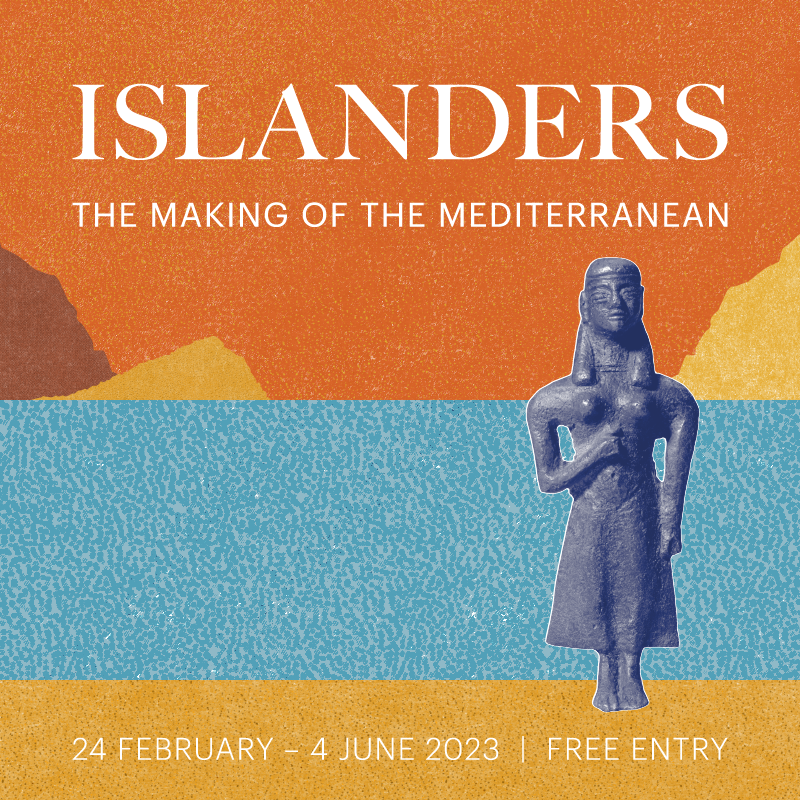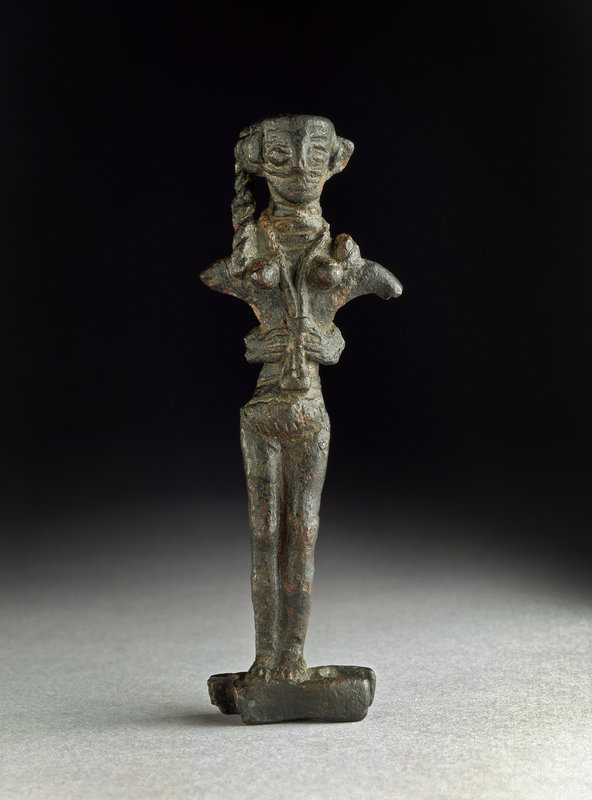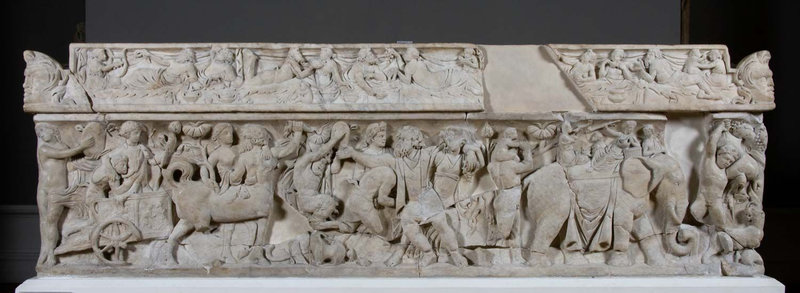4,000-year-old Mediterranean cultural treasures go on show in the UK for the first time
CAMBRIDGE - Throughout history, islands have been romanticised as remote places quite unlike the mainland. A major new exhibition Islanders: The Making of the Mediterranean (24 February – 4 June) will transport visitors back 4,000 years to the islands and sea of the ancient Mediterranean. It will bring to the UK an unprecedented group of over 200 antiquities on loan, most for the first time, from three of the largest Mediterranean islands – Sardinia, Cyprus, and Crete - to demystify the identity of island life and show that the evolution of the Mediterranean world was defined by how connected the islands were across three millennia.
These extraordinary loans will reveal lost island civilisations of trading powers across the Mediterranean that far from operating in isolation, actively sought out new markets to bring the islands wealth and materials to advance their cultures.
The Bronze Age site of Su Nuraxi di Barumini, in Marmilla, south-central Sardinia (Province of Medio Campidano), is one of the central sites featured as part of the Being an Islander project. Photo @ Christophilopoulou 2019.
Sardinia’s famous bronze votive figurines (bronzetti) will be on loan to the UK for the first time from the National Archaeological Museum of Cagliari. The lost 4,000-year-old Nuragic civilization of Sardinia, lasted from the onset of the second millennium BCE (ca. 2000- 1800 BCE) to the Roman colonisation (238 BCE). While the Nuragic civilisation may be extinct and stories of their history now the stuff of legends, the magnificent material culture they left behind is testament to a mighty island society.
No written records of this civilisation have been discovered, it is only through its ancient burial grounds that have yielded up countless unique bronze figurines, that their mythological and religious identity can be understood. Nuragic bronze figurines represented warriors, ships, and imaginary entities belonging to a unique culture.
At the peak of its power, the Nuragic culture was defined by megalithic stone towers called nuraghi. Archaeologists estimate that over ten thousand nuraghi once existed across Sardinia, although now only a few thousand survive. An extraordinary bronze ‘navicella’ boat figurine from Orroli, Sardinia, (ca. 1000- 700 BCE) with a central mast representing the Nuragic towers, is a symbol of control over sea routes at a time when Nuragic Sardinia was well connected to southern Italy, and other islands such as Cyprus, for maritime trade. The boat is a powerful reminder that the characteristic Nuragic towers were not only visible throughout the island but also a potent cultural symbol. The widespread use of bronze, a metal which was not present in Sardinia, is material proof of the mobility and extensive trade of the Nuragic island people.
Nuraghe Sebrissi, Osini, Sardinia, dated ca. 1800–1000 BCE.
Bronze Age fresco of a ship procession from Akrotiri on the Aegeanisland of Thera (modern-day Santorini), from Room 5 of the West House,ca. 2000–1500 BCE.
Bronze ‘navicella’ boat, Orroli, Sardinia, 1000–600 BCE. Bronze, h. 10.5 x w. 20.9 x d. 7.8 cm, National Archaeological Museum, Cagliari, 45038 © National Archaeological Museum of Cagliari
A bronze figurine of an archer was excavated at the Iron Age sanctuary of Abini Teti, Sardinia. Discovered in 1865, the sanctuary revealed evidence of a community that was devoted to the smelting and production of bronze artefacts. It is one of the best-known Nuragic cult sites (c. 1000- 600 BCE) due to the incredible number of bronze votives that have been found there.
A bronze figurine of an archer, Sanctuary of Abini, Teti, Sardinia, 1000–700 BCE. Copper, h. 16.3 x w. 10.7 d. 2.4 cmNational Archaeological Museum, Cagliari, 20841 © National Archaeological Museum of Cagliari
Bronze warrior with four eyes, Sanctuary of Abini, Teti,Sardinia, ca. 1000–600bceBronze, h. 14 x w. 7.2 x d. 5.8 cmNational Archaeological Museum, Cagliari, 20816 © National Archaeological Museum of Cagliari
A unique representation of a figurine pair depicting grief will also be on loan. The figurine of a mourning mother holding her deceased child (1000-700 BCE) originates from the important Nuragic Iron age sanctuary of Santa Vittoria Serri, in Sardinia. The female figure sitting on a stool, holds a naked child on her lap. Her hand is raised in prayer; the child, rests its feet on a stool.
Bronze figurine of a seated woman with a child, Santa Vittoria Serri, Sardinia, 1000–600 BCE. Bronze, h. 10.4 x w. 4.6 x d. 5.8 cm, National Archaeological Museum, Cagliari, 40573 © National Archaeological Museum of Cagliari
Votive figurines commonly referred to as the ‘terracotta army of Cyprus’, found at the outstanding sanctuary of Agia Eirini will also be on loan to the UK from the Archaeological Museum of Nicosia, Cyprus, for the first time.
A chance discovery by the Swedish Cyprus Expedition in 1929, led to the excavation of this cultural treasure, the sanctuary of Agia Eirini, in the north-west coast of Cyprus, in use between the Late Bronze Age (1650-1050 BCE) and the end of the 6th ce BCE. The uncovered open- air shrine revealed an astounding 2,000 clay votive figurines, larger than life-size human figures, alongside sphinxes, minotaurs, priests with bull-masks, and horse drawn chariots, such as the one pictured. They were placed as votive offerings in concentric semi-circles around a limestone altar within the large open court of the sanctuary. These clay figures are the most compete representation ever found of Cypriot society of this period.
About two-thirds of the unique archaeological finds are now the core of the Cypriot collections of the Stockholm Medelhavsmuseet. 500 figurines remain in Cyprus and are one of the cultural treasures in the Archaeological Museum of Nicosia.
Finds at the Sanctuary of Agia Eirini, Cyprus. © Världskulturmuseerna, Sweden
Figure of a male, Agia Eirini, Cyprus, ca. 700–600 BCE. Ceramic, h. 85 cm, Cyprus Museum, AI 1566. © Cyprus Department of Antiquities
Model of a horse-drawn chariot and rider, Sanctuary of Agia Eirini, Cyprus, 750–600 BCE. Ceramic, h. 17.5 x w. 26.2 cmCyprus Department of Antiquities, AI 1781+798. © Cyprus Department of Antiquities
The exhibition will also reunite for the first time the finds from the unique Early Bronze Age cemetery of Bellapais-Vounous (ca. 2200-1950 BCE), Cyprus. These emblematic objects of early Cypriot art and religion have shaped our understanding of this formative stage of the island’s Bronze Age. Amongst the material on show will be objects never before seen in the UK from the Department of Antiquities in Cyprus, elaborate ceremonial ‘tulip bowls’, vessels decorated with animal protomes, and life size clay models of inanimate objects, contextualised by the Fitzwilliam’s Cypriot antiquities.
Clay pyxis (box) with human figures from cemetery of Bellapais-Vounous Cyrus (c.2000 BCE) © Cyprus Museum
Pedestal bowl from cemetery of Bellapais Vounous (c.2250/2200-2100/2050 BCE) © Cyprus Museum
Clay burial chest (larnax) (ceramic, ca. 2000–1800 BCE). Found cemetery of Pacheia Ammos, Crete. Heraklion Archaeological Museum.
Barrel-shaped jug, Cyprus, unknown findspot, ca. 750-600 BCE. Ceramic, h. 45.1 x w. 36.2 x d. 29.6 cm (with mount). Fitzwilliam Museum, Cambridge, Loan Ant.103.97,on long- term loan from Corpus Christi College. © Fitzwilliam Museum, Cambridge
Other exhibition highlights are:
A rare 3,500-year-old ox-hide-shaped ingot on loan from the Heraklion Museum, Crete. The production of bronze in the Mediterranean defined an age (Bronze Age cultures) and Cyprus became the centre of metal production throughout the whole of the ancient world. These copper ingots were a standard form of transporting the raw material, which was cast in special moulds at the smelting site. Ingots were traded across the Mediterranean for making vessels, tools, and figurines. This example from the Bronze Age Mediterranean copper trade linked seafarers from Crete to Cyprus and Sardinia.
Bronze ingot in the form ofan oxhide, Valenza-Serra, Storeroom, Ilixi, Sardinia, ca. 1300–1100 BCE. Copper, h. 7 x w. 66.5 x d. 34.7 cm, National Archaeological Museum, Cagliari, 5485 © Museo Archeologico Nazionale di Cagliari
Two rare figurines on loan from the Ashmolean Museum; a miniature crawling baby, found in the caves of Psychro and Ida eastern Crete, the only sacred caves that have yielded human figurines in Bronze Age Crete (c. 3200- 1200 BCE); and a copper figurine depicting the goddess Astarte, from Cyprus, a deity worshipped
from the Bronze Age through classical antiquity. She is shown standing on a miniature ‘oxhide-ingot’ a copper ingot shaped like the hide of an ox for easy shipping. There are only two more figurines of this kind, a type known as ‘Astarte-on-the-Ingot’, they represent a goddess associated with metallurgy, thought to ensure the productivity of the mines and protect the island’s copper industry at its heyday in the 12th century BCE. This exceptional figurine exemplifies the story of production, trade and dissemination of copper and bronze artefacts from Cyprus to the rest of the Mediterranean.
Figurine of a crawling baby, Psychro Cave, Lasithi plateau, Crete, 1600–700 BCE. Copper alloy, h. 2.8 x l. 4.8 cmAshmolean Museum, Oxford, AN1938.1162 © Ashmolean Museum
Copper alloy figurine of Astarte standing on an ingot, Cyprus, possibly Enkomi, 1200–1100 BCE. Copper alloy, h. 9.9 cm. Ashmolean Museum, Oxford, AN1971.888 © Ashmolean Museum
Pioneering new interdisciplinary scientific research has shed new light on islanders’ lives, their technologies and the mobility and interaction of island people. The research project at the Fitzwilliam investigated the materials, methods of production and use of metal objects from Cyprus, Crete and Sardinia, dating from the Early Bronze Age to the beginning of the Classical period (ca 2000-500 BCE). The oldest objects investigated were two copper-based toggle-pins found in the Early Bronze Age cemetery at Bellapais-Vounous, on Cyprus’ north coast. This pair presented some of the earliest known examples found on the island.
Toggle-pins, Cemetery of Bellapais-Vounous, Tomb 84, Cyprus, ca. 2200–2050 BCE. Copper, l. 14.3 x w. head 1.0 cm. Fitzwilliam Museum, Cambridge, GR.5i.1939 and GR.5j.1939. © The Fitzwilliam Museum, Cambridge.
They were found in position on the shoulders of one of two individuals buried in the tomb, their pointed tips directed toward the head, and with remnants of now-mineralised thread still preserved in their toggle-holes. Our analysis of a rare "silver-studded sword" carried by the Homeric warriors found in the tombs of the Iron Age kings of Tamassos, located near foothills of the Troodos Mountains in central Cyprus revealed it to be a high-status object made with a unique mix of iron and decorated with carved ivory plates and silver.
Iron sword, Tamassos, near Politiko, central Cyprus, ca. 600–480 BCE. Iron, l. 70.53 x w. (across hilt) ca. 11 cm. Fitzwilliam Museum, Cambridge, GR.334.1892 © The Fitzwilliam Museum, Cambridge.
The exhibition curator and Being an Islander project principal investigator, Dr Anastasia Christophilopoulou said ‘Ultimately, we see identity as a form of social expression, our sense of belonging to a group based on similarities and differences. Objects presented in this show reveal that ‘being an islander’ is a highly fluid state of being, whether consciously or not, both in the past and the present. Islanders regard all aspects of life as inseparable parts of who they are. Their identities are always in a state of becoming, a journey in which we never arrive. This exhibition brings together three years of research, community engagement and active archaeological and anthropological practice in the Mediterranean islands. We must picture ourselves in one of these islands, to better understand how these unique objects reveal self-perceptions, community identity and the islands’ long histories. A sense of place, geography, natural environment, and the deep connection of the islanders with the sea, make them who they are. Imagine beyond the labels, to be transported to an island setting, where objects, communities and landscape are one.’
Dott. Francesco Muscolino, Director of the National Archaeological Museum, Cagliari, said ‘For the Archaeological National Museum of Cagliari, the participation in the exhibition and in the connected research project is a great opportunity of underlining the richness and manifoldness of Sardinian Mediterranean connections throughout the ages. The inclusion of Cagliari Museum antiquities, most of which has never travelled to the UK or abroad, gives a substantial contribution in creating comparisons with similar objects belonging to coeval insular civilizations, thus vividly showing the links among some of the main Mediterranean islands.’
Dr. Marina Solomidou-Ieronymidou, Director of the Department of Antiquities, Cyprus said ‘We are especially delighted to be a part of this exceptionally dynamic and multifaceted project. Over 50 Cypriot antiquities, from Cyprus’ national museums, will be on loan for the exhibition. Tracing the complex identities that emerge from the study of the ancient remains of three Mediterranean large islands, namely Cyprus, Sardinia and Crete, is a truly fascinating endeavour. Insularity and interaction, innovation and tradition, diversity and tolerance can be seen as important elements of island identities.
‘The Mediterranean Sea, which is what makes these lands islands, has been acting through the millennia as a constant force that has enabled or cut off communication, has isolated or opened up, acting sometimes as a silent or at other periods as a loud stimulus for ancient islander communities. Cyprus, the third largest island in the Mediterranean, located at the intersection of three continents, where the Orient meets the Occident, has always been in the crossroads of so many different and diverse cultures. The islands’ ancient communities have been in a continuous dialogue with other Mediterranean communities, including those of Sardinia and Crete, we look forward to viewing the cultural objects of these three islands side by side, in a creative dialogue for the first time.'
Terracotta head of a male, from a colossal figure, Salamis, Toumba, Cyprus, ca. 750–600 BCE. Ceramic, h. 23.8 x w. 26.3 x l. 39 cm, Ashmolean Museum, Oxford, AN1909.837 © Ashmolean Museum, Oxford
Statue of Aphrodite Anadyomene, Salamis, Cyprus, ca. 300–100 BCE. Marble, h. 116 x w. 44 cm, Cyprus Museum, Sal. St. 20A © Cyprus Museum
Sarcophagus showing Dionysos returning from India, Arvi, Crete, 100–200 CE. Marble, h. 0.697 x l. 2.22 x w. 0.67 m. Fitzwilliam Museum, Cambridge, Gr. 1.1835 © The Fitzwilliam Museum, Cambridge.

/https%3A%2F%2Fprofilepics.canalblog.com%2Fprofilepics%2F1%2F0%2F100183.jpg)
/https%3A%2F%2Fstorage.canalblog.com%2F03%2F02%2F119589%2F96711876_o.jpg)
/https%3A%2F%2Fstorage.canalblog.com%2F11%2F31%2F119589%2F94773502_o.jpg)
/https%3A%2F%2Fstorage.canalblog.com%2F20%2F83%2F119589%2F94772815_o.jpg)
/https%3A%2F%2Fstorage.canalblog.com%2F26%2F72%2F119589%2F75604929_o.jpg)
/https%3A%2F%2Fstorage.canalblog.com%2F59%2F60%2F119589%2F26458628_o.jpg)



























/image%2F1371349%2F20240425%2Fob_c453b7_439605604-1657274835042529-47869416345.jpg)
/image%2F1371349%2F20240425%2Fob_59c6f0_440358655-1657722021664477-71089985267.jpg)
/image%2F1371349%2F20240425%2Fob_07a28e_440353390-1657720444997968-29046181244.jpg)
/image%2F1371349%2F20240425%2Fob_0b83fb_440387817-1657715464998466-20094023921.jpg)